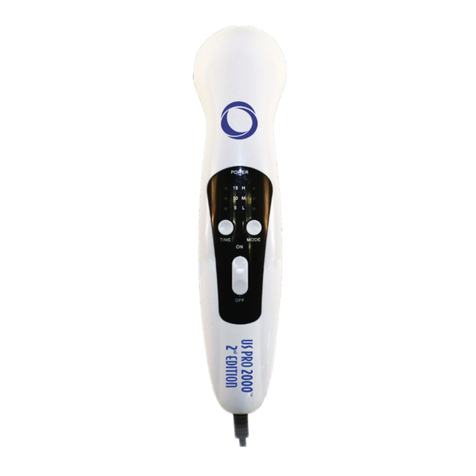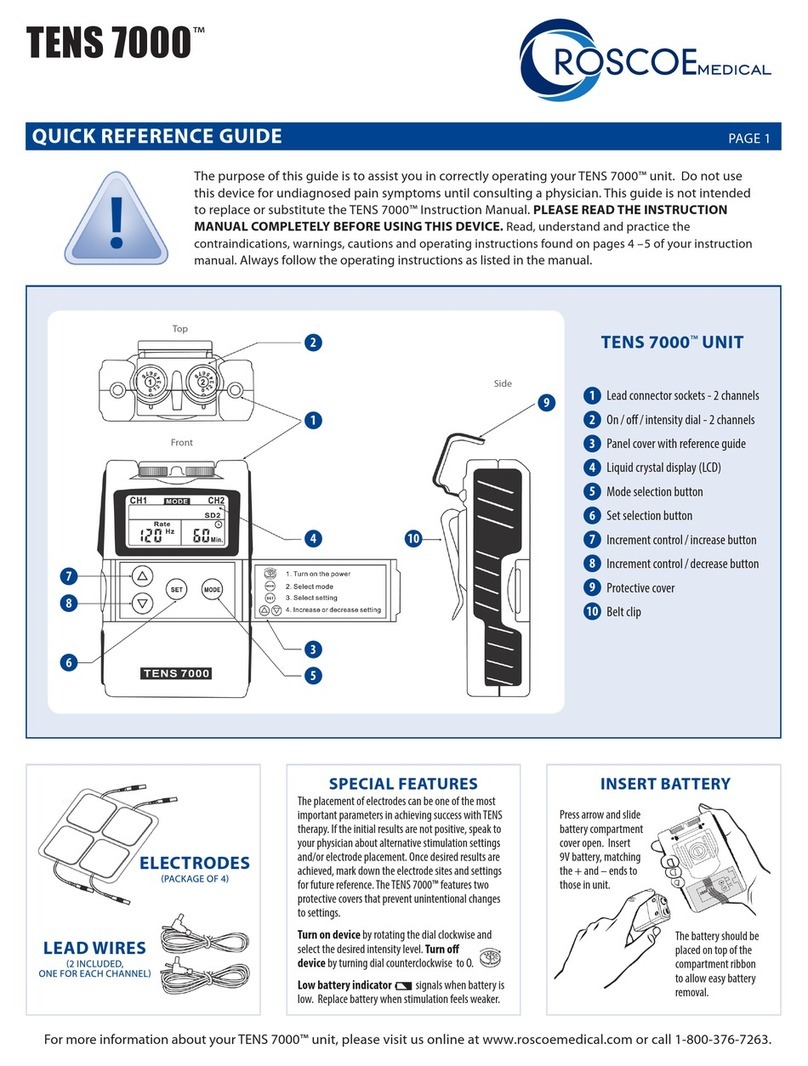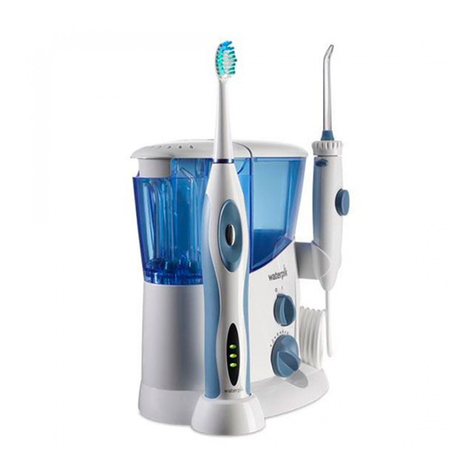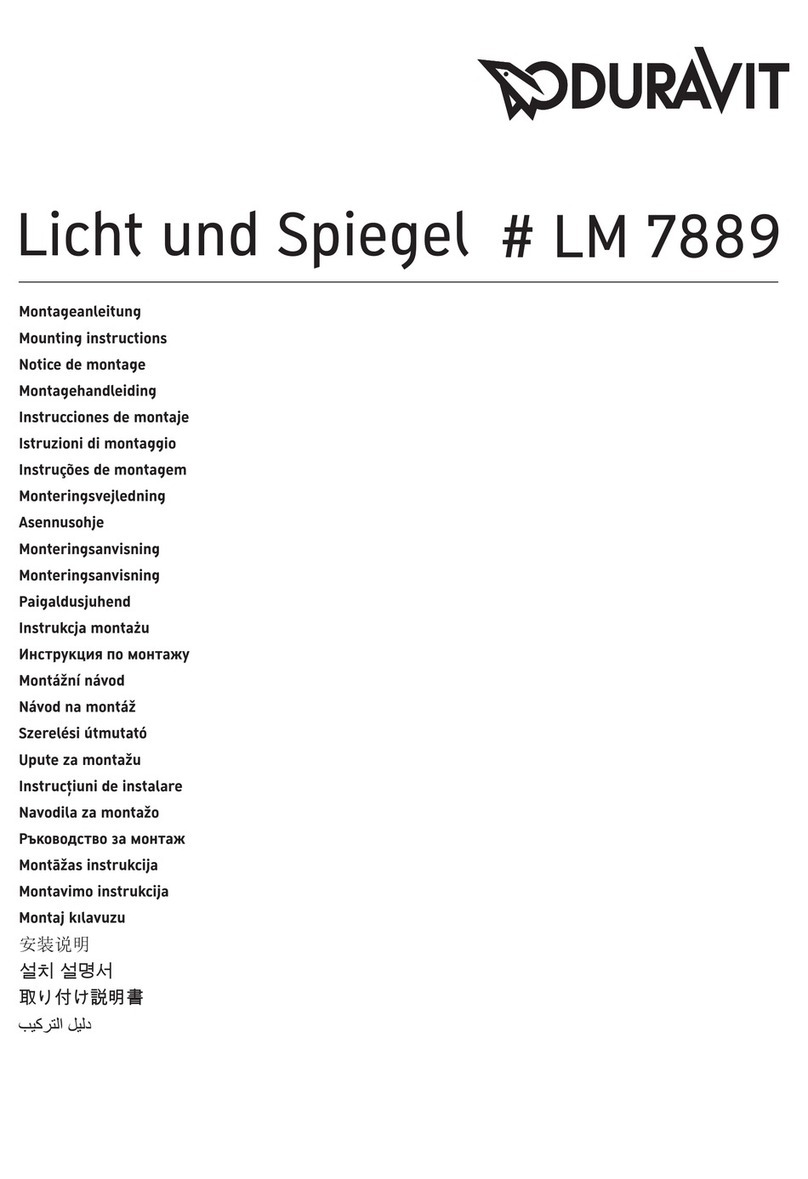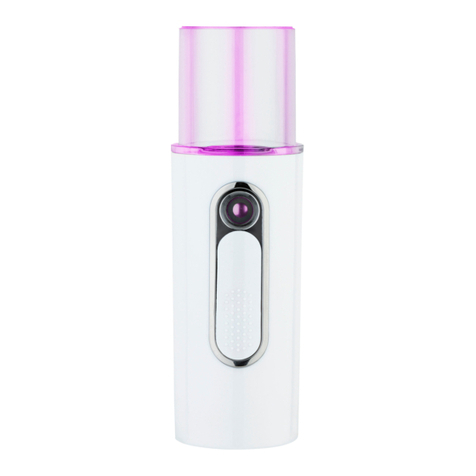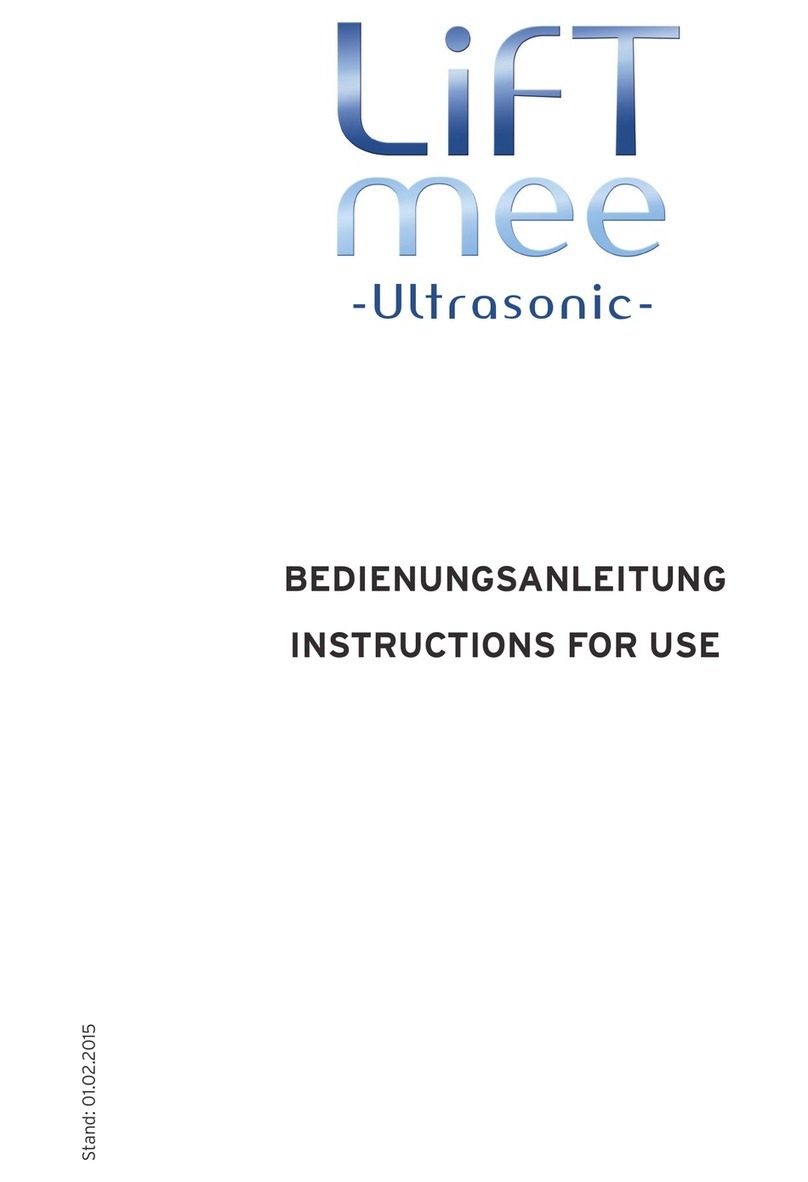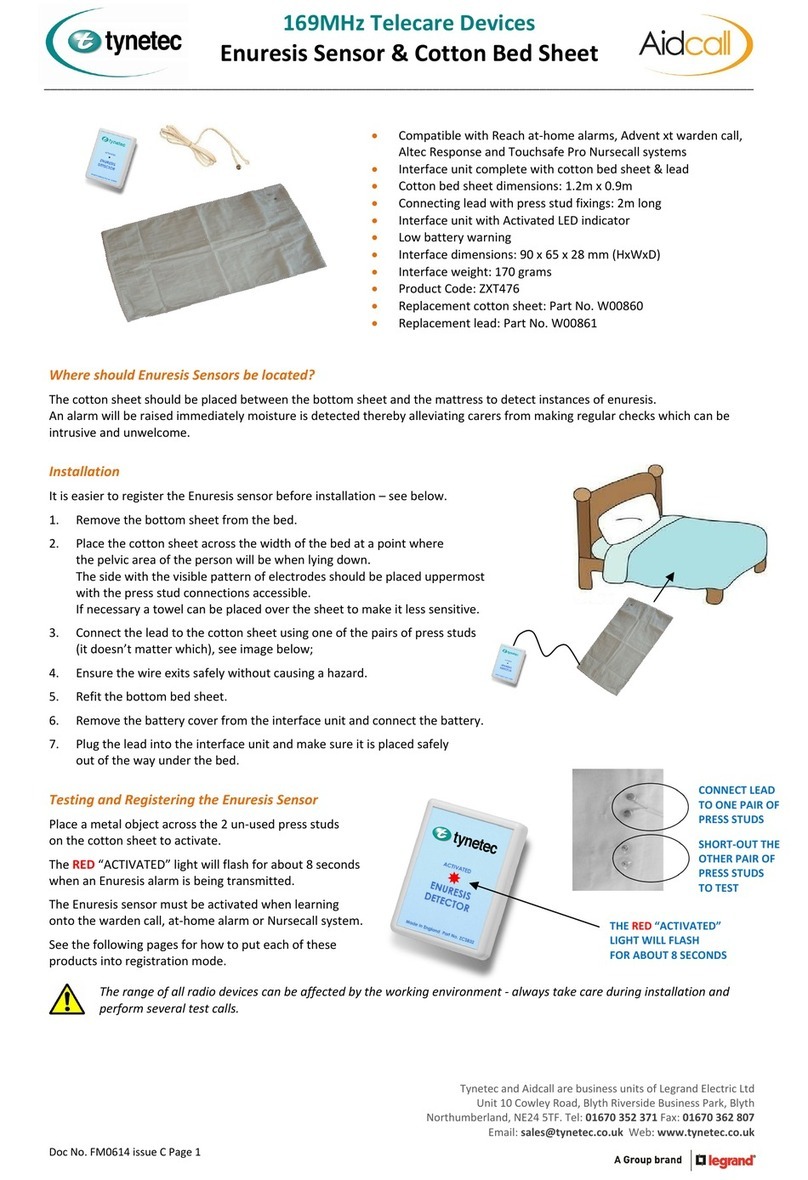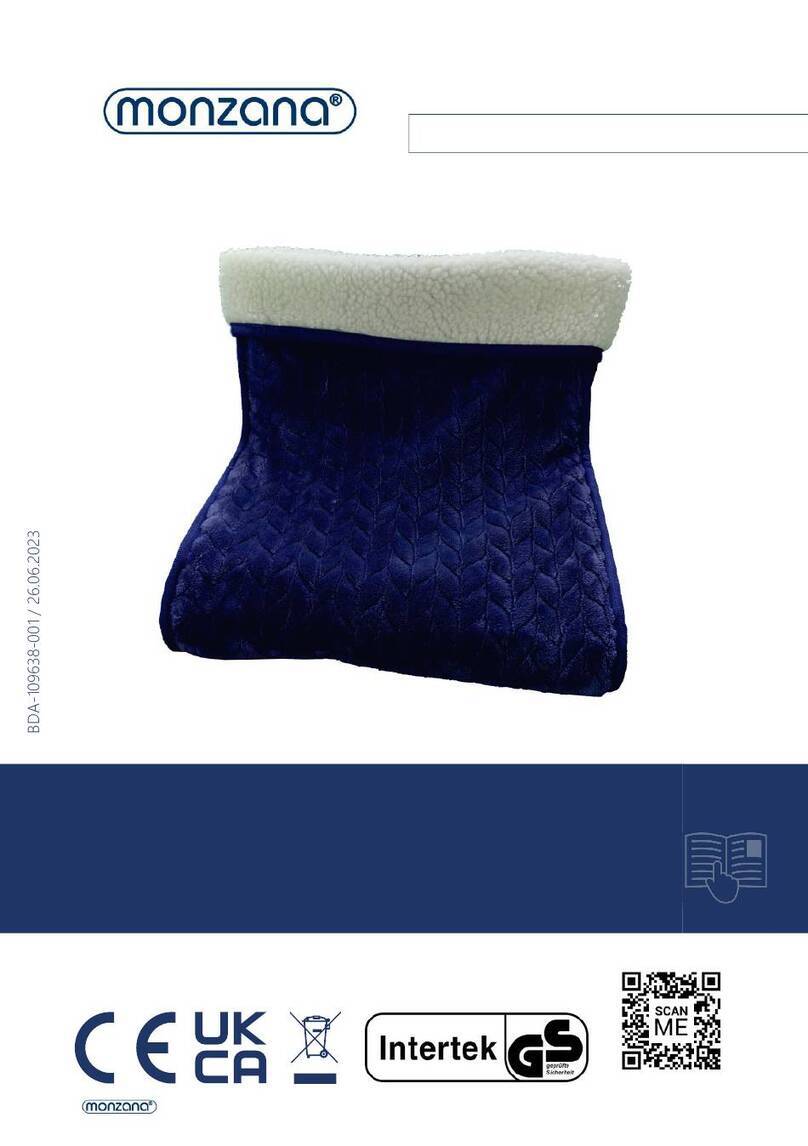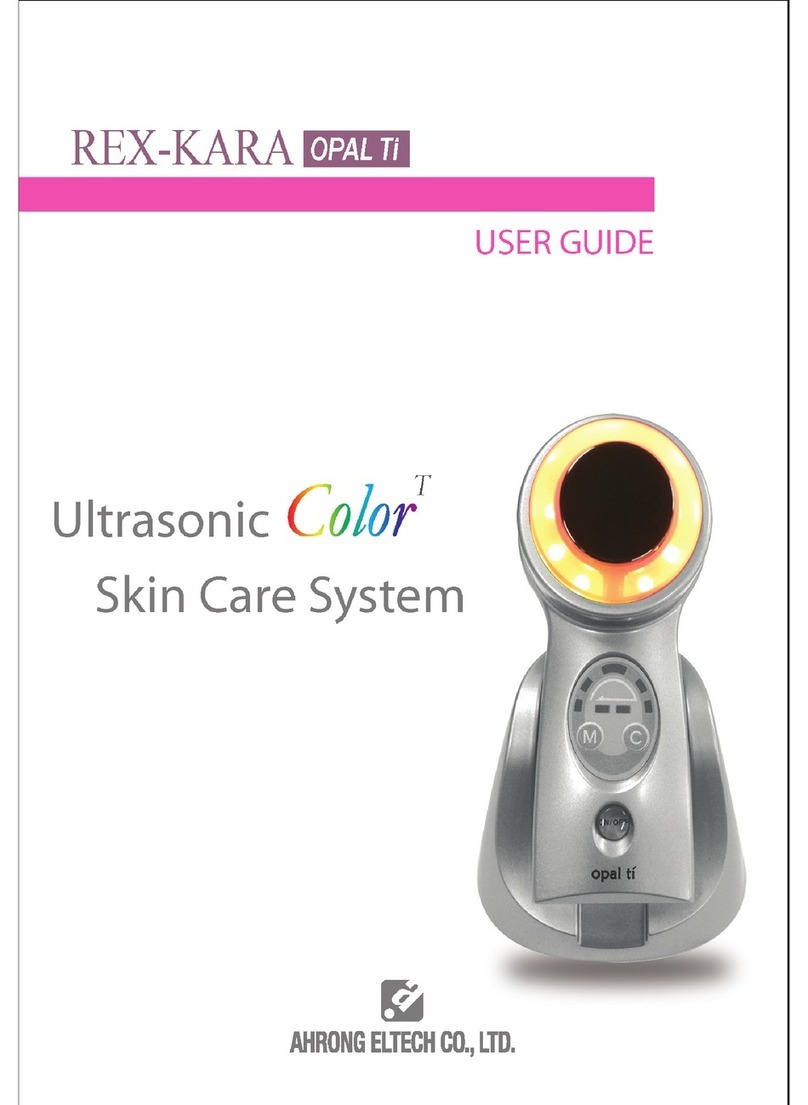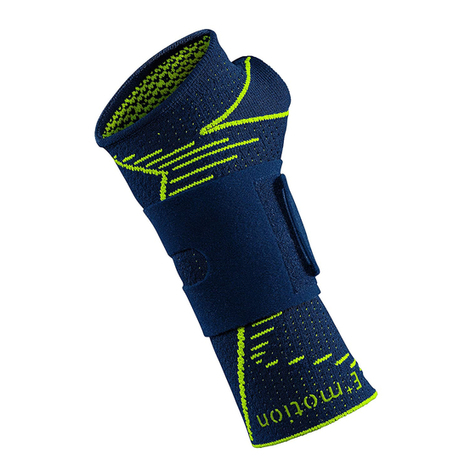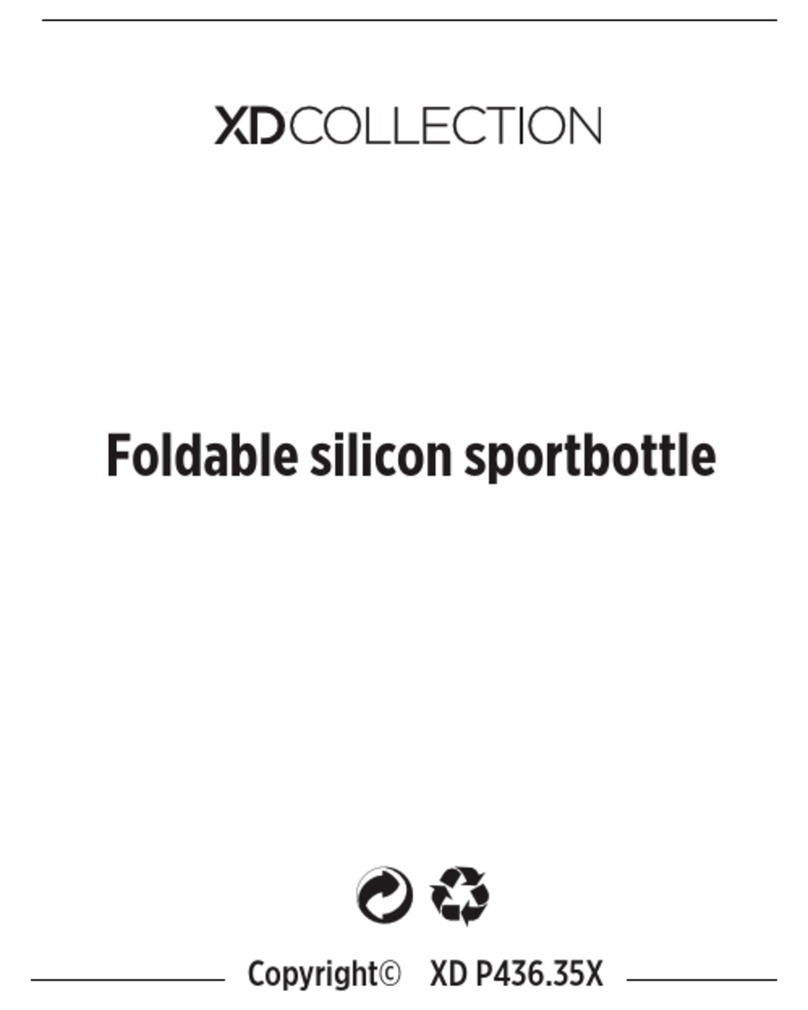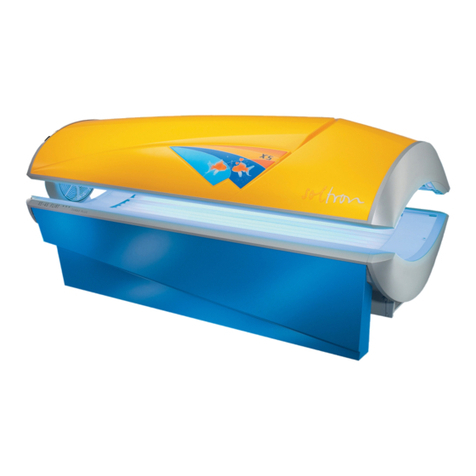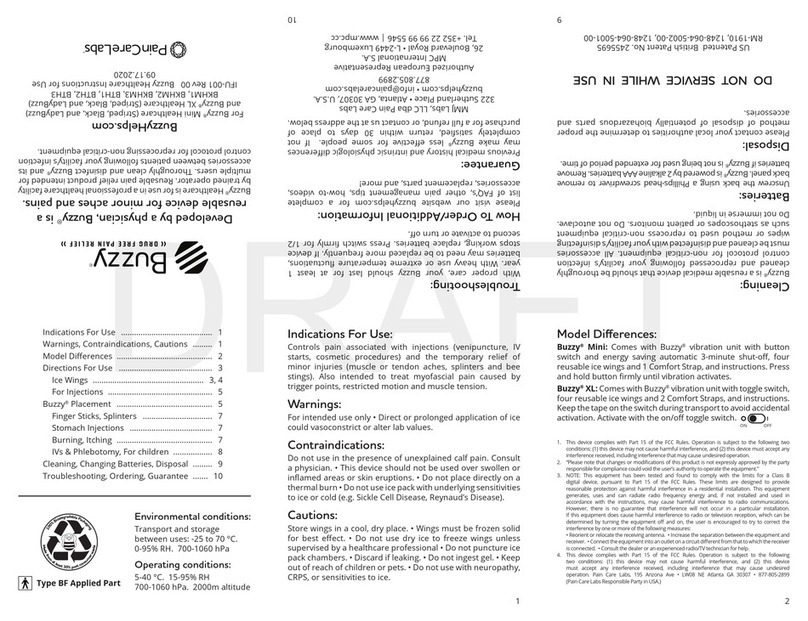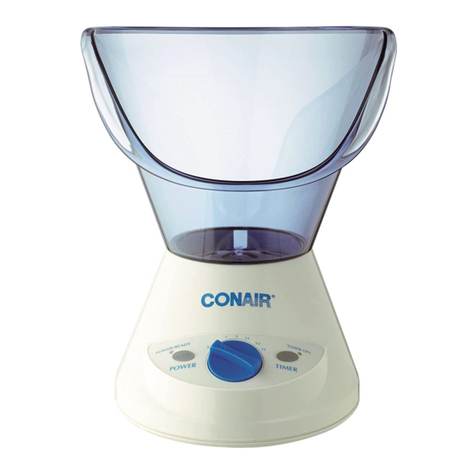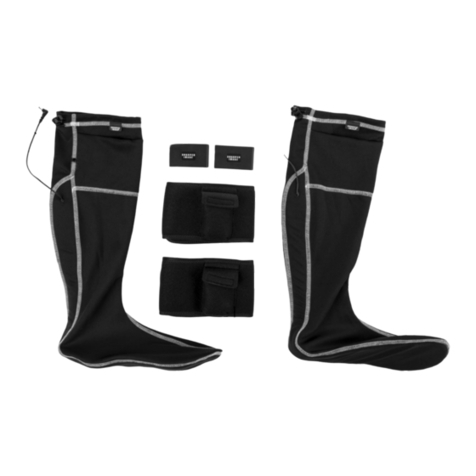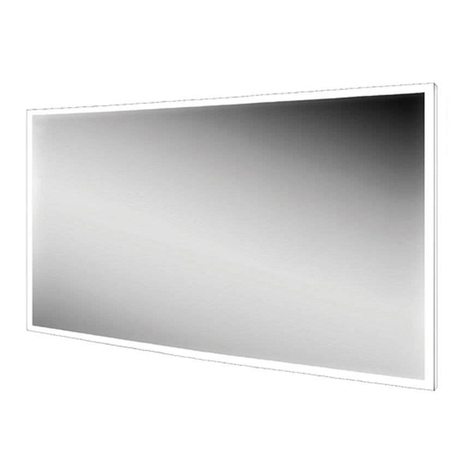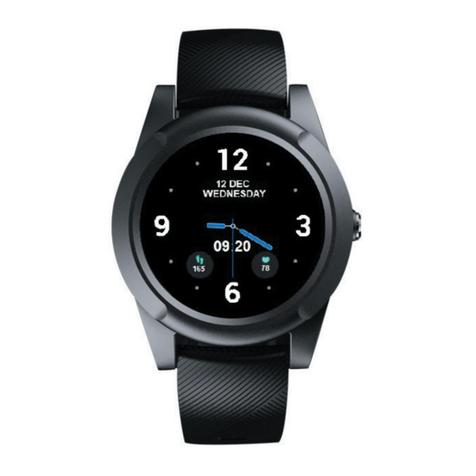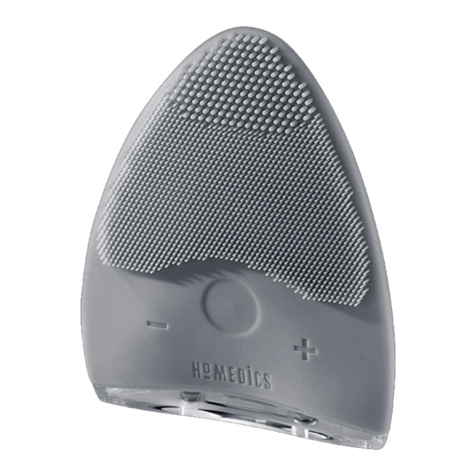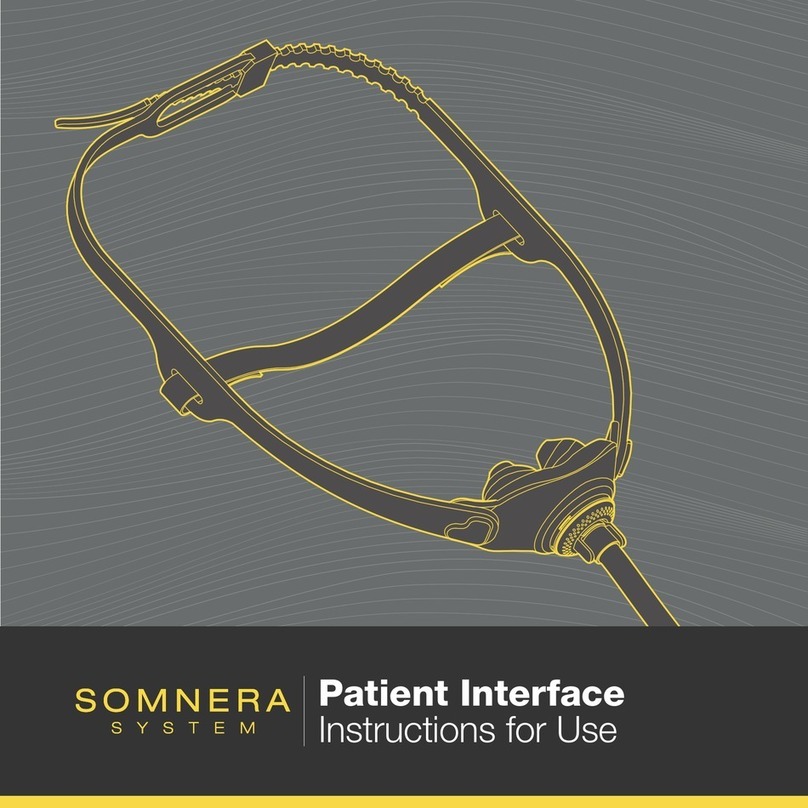Roscoe Medical TENS 3000 User manual

INSTRUCTION MANUAL
for the
TENS 3000
Manufactured for
Roscoe Medical, Inc.
21973 Commerce Parkway,
Strongsville, Ohio 44149
www.roscoemedical.com


INDEX
Chapter Contents Page
1. Introduction............................................................................................. 2
2. Cautions .................................................................................................. 3
3. Warnings.................................................................................................. 4
4. General Description................................................................................ 5
5. Construction ........................................................................................... 5
6. TechnicalSpecications ........................................................................ 6
7. Replaceable Parts................................................................................... 7
8. Accessories............................................................................................. 7
9. Graphic Symbols .................................................................................... 8
10. Parameter Controls ................................................................................ 8
11. Attachment of Electrode Lead Wires.................................................. 10
12. Lead Wire Maintenance........................................................................ 10
13. Electrode Options................................................................................. 11
14. Electrode Placement ............................................................................ 11
15. Tips for Skin Care................................................................................. 12
16. Application of Re-usable Self Adhesive Electrodes.......................... 13
17. Adjusting the Controls......................................................................... 14
18. Battery Information............................................................................... 17
19. Maintenance, Transportation and Storage of TENS Device ............. 19
20. Safety Control ....................................................................................... 20
21. Malfunctions.......................................................................................... 20
22. Conformity to Safety Standards.......................................................... 21
23. Warranty ................................................................................................ 21
1

CHAPTER 1: INTRODUCTION
EXPLANATION OF PAIN
Pain is a warning system and the body's method of telling you that something is
wrong. Pain is important; without it, abnormal conditions many go undetected,
causing damage or injury to vital parts of our bodies.
Even through pain is a necessary warning signal of trauma or malfunction in the
body, nature may have gone too far in its design. Aside from its value in diagnosis,
long-lasting persistent pain serves no useful purpose. Pain does not begin until
a coded message travels to the brain where it is decoded, analyzed, and then
reacted to. The pain message travels from the injured area along the small nerves
leading to the spinal cord. Here the message is switched to different nerves
that travel up the spinal cord to the brain. The pain message is then interpreted,
referred back and the pain is felt.
EXPLANATION OF TENS
Transcutaneous Electrical Nerve Stimulation is a non-invasive, drug-free method
of controlling pain. TENS uses tiny electrical impulses sent through the skin to
nerves to modify your pain perception. TENS does not cure any physiological
problem; it only helps control the pain. TENS does not work for everyone;
however, in most patients it is effective in reducing or eliminating the pain, allowing
for a return to normal activity.
HOW TENS WORKS
There is nothing "magic" about Transcutaneous Electrical Nerve Stimulation
(TENS). TENS is intended to be used to relieve pain. The TENS unit sends
comfortable impulses through the skin that stimulate the nerve (or nerves) in the
treatment area. In many cases, this stimulation will greatly reduce or eliminate
the pain sensation the patient feels. Pain relief varies by individual patient, mode
selected for therapy, and the type of pain. In many patients, the reduction or
elimination of pain lasts longer than the actual period of stimulation (sometimes
as much as three to four times longer). In others, pain is only modied while
stimulation actually occurs. You may discuss this with your physician or therapist.
Chapter 2 : CAUTIONS
1. Precautions:
Isolated cases of skin irritation may occur at the site of electrode placement
following long-term application. Effectiveness is highly dependent upon patient
selection by a person qualied in the management of pain patients.
2. Contradictions:
TENS devices can affect the operation of demand type cardiac pacemakers.
TENS is not recommended for patients with known heart disease without
physical evaluation of risk. Do not use TENS on the carotid sinus( neck)
region. Do no apply TENS for undiagnosed pain syndromes until etiology is
established. Do not stimulate on the site that may cause current to ow trans-
cerebrally (through the head).
3. Adverse Reactions:
Possible allergic to gel, skin irritation and electrode bum are potential adverse
reactions.
4. Read operation manual before use of TENS.
5. We emphasize that patient with an implanted electronic device (for example,
a pacemaker) should not undergo TENS treatment without rst consulting a
doctor. The same applies to patients with any metallic implants.
6. If TENS therapy becomes ineffective or unpleasant, stimulation should
be discontinued until its use is reevaluated by the physician or therapist.
7. Avoid adjusting controls while operating machinery or vehicles.
2 3

8. Turn the TENS off before applying or removing electrodes.
9. TENS devices have no AP/APG protection. Do not use it in the presence of
explosive atmosphere and ammable mixture.
Chapter 3: WARNINGS
1. Caution should be used in applying TENS to patients suspected of having heart
disease. Further clinical data is needed to show there are no adverse results.
2. The safety of TENS devices for use during pregnancy or birth has not been
established.
Do not use TENS during pregnancy.
3. TENS is not effective for pain of central origin. (This includes headache.)
4. TENS devices should be used only under the continued supervision of a physician.
5. TENS devices have no curative value.
6. TENS is a symptomatic treatment and as such suppresses the sensation of pain
which would otherwise serve as a protective mechanism.
7. Electronic monitoring equipment (such as ECG monitors and ECG alarms) may
not operate properly when TENS stimulation is in use.
8. There should be a prominently placed statement warning that stimulus delivered
by this device may be sufcient to cause electrocution. Electrical current of this
magnitude must not ow through the thorax because it may cause a cardiac
arrhythmia.
9. Do not place electrodes on the front of the throat as spasm of the Laryngeal and
Pharyngeal muscle may occur.
10. Care should be taken so that when operating potentially dangerous machinery
the stimulator controls are not changed abruptly.
11. Electrodes should not be placed over the eyes, in the mouth, or internally.
12. Keep this device out of the reach of children.
13. Caution: Federal law restricts this device to sale by or no the order of a physician.
Chapter 4 : GENERAL DESCRIPTION
The TENS 3000 is a battery operated pulse generator that sends electrical impulses
electrodes to the body and reach the nerves causing pain. The device is provided
with two controllable output channels, each independent of each other. An electrode
pair can be connected to each output channel.
The electronics of the TENS 3000 create electrical impulses whose Intensity,
duration, number per second and modulation may be altered with the controls or
switches. Dial controls are very easy to use and the slide cover prevents accidental
changes in the setting.
Chapter 5: CONSTRUCTION
4 5
(1) CAP
(2) LEAD CONNECTOR
(3) INTENSITY CONTROL
(ON/OFF SWITCH)
(4) LED
(5) MODE
(6) PULSE WIDTH
(7) PULSE RATE
(8) TIMER
(9) BATTERY STRIP
(10) BATTERY
COMPARTMENT

Chapter 6: TECHNICAL SPECIFICATIONS
The technical specication details of the TENS 3000 are as follows:
MECHANISM TECHNICAL DESCRIPTION
01. Channel Dual, isolated between channels
02. Pulse Amplitude Adjustable, 0-80mA at 500 ohm load each channel
03. Pulse Rate Adjustable, from 2 to 150 Hz
04. Pulse Width Adjustable, from 30 to 260 microseconds
05. Modulation Pulse rate is automatically varied in a cyclic pattern
over an interval of nominally 10 seconds (in max 150
Hz). Pulse rate decreases lineally over a period of
4 seconds from the control setting to a value which
is 40% less. The lower pulse rate will continue for
1 second. Then increase linearly over a 4 second
period to its original value. The original pule rate will
continue for 1 second. The cycle is then repeated.
06. Burst Mode Bursts occur twice every second. Pulse width
(adjustable), frequency = 100Hz.
07. Wave Form Asymmetrical Bi-Phasic Square Pulse.
08. Timer 15, 30 minutes or continuous.
09. Voltage 0 to 40 V (Load: 500 ohm).
10. Max. Charge per
Pulse
20 micro-coulombs.
11. Power Supply One 9 Volt Battery (alkaline or nickel-cadmium
rechargeable).
12. Battery Life Approximately 50 hours at nominal settings.
13. Size 95 (H) x 65 (W) x 23.5 (D) mm.
14. Weight 115 grams (battery included)
Chapter 7: REPLACEABLE PARTS
The replaceable parts and accessories of TENS devices are as given below-Except
leads, electrodes and battery, battery case cover, please do not try to replace the
other parts of a device.
PIECES
01 ELECTRODES LEADS
02 ELECTRODES
03 9V BATTERY, TYPE 6F22
04 BELT CLIP
05 BATTERY CASE COVER
06 LEAD CONNECTOR
07 MAIN PCB
08 INTENSITY KNOB
09 B-N-M SWITCH
10 PULSE WIDTH KNOB
11 PULSE RATE KNOB
Chapter 8: ACCESSORIES
Each set TENS 3000 are completed with standard accessories and standard label
as given below:
DESCRIPTION QUANTITY
1. 40 X 40 mm Adhesive Electrodes 4 pieces
2. Electrode Leads 2 pieces
3. 9 V Battery, type 6F22 1 piece
4. Instruction Manual 1 piece
5. Carrying Case 1 piece
6 7

Chapter 9: GRAPHIC SYMBOLS
1. Equipment capable of delivering output values in excess of
10mA r.m.s. or 10V r.m.s. averaged over any period of 5s.
2. Type BF applied part.
3. Do not insert the plug into AC power supply socket.
4. Direct Current (DC power source)
5. Refer to Instruction Manual.
Chapter 10: PARAMETER CONTROLS
PUSLE DURATION
Wider Pulse Duration settings will deliver stronger stimulation for any given intensity
setting. As mentioned in the Controls Section, by using a combination of intensity
and pulse duration, it is felt that various pulse widths are capable of stimulation
different groups of nerve bers.
The choice of which pulse duration to use is partially dependent upon the Treatment
Mode and Protocol selected (refer to the appropriate section).
PULSE RATE
The Pulse Rate (hertz or pulses per second) chosen depends greatly upon the type
of electrode placement given to the patient.
When using contiguous and dermatome electrode placements (i.e. stimulating
directly through the area of pain or localized enervation), a quick pulse rate (setting
greater than 80Hz on the Pulse Rate Control) is desired. The patient should not
perceive individual pulses but rather have the sensation of steady continuous
stimulation.
Despite above recommendations, these individual patients may require slight
variations of the above settings, according to the nature of their condition.
TREATMENT MODE
Normal or Conventional TENS offers the practitioners complete control over all the
various treatment parameters of the instrument.
Burst Mode is analogous to the Low Rate TENS technique except the low frequency
individual pulses are replaced by individual "bursts" of 7-10 individual pulses. It is
thus a combination of Conventional TENS and Low Rate TENS. In Burst Mode,
the treatment frequency is xed by the instrument and is not adjustable with the
Frequency Rate control.
Modulated Mode attempts to prevent nerve accommodation by continuously cycling
the treatment intensity. When using Modulated Mode increase the intensity only
when the unit is at the maximum intensity of the modulation cycle. If the intensity
is increased during a low intensity period of the cycle, the patient may turn up the
control very slowly, so that they may feel the intensity any higher.
TIME DURATION
The onset of pain relief should occur shortly after the intensity setting has been
determined. However, in some cases, pain relief may take as long as 30 minutes to
achieve. TENS units are typically operated for long periods of time, with a minimum
of 20 - 30 minutes and in some post-operation protocols, as long as 36 hours.
In general, pain relief will diminish within 30 minutes of the cessation of stimulation.
8 9

Chapter 11: ATTACHMENT OF ELECTRODE
LEAD WIRES
The wires provided with the system insert into the jack sockets located on top of the
device. Holding the insulated portion of the connector, push the plug end of the wire
into one of the jacks (see drawing); one or two sets of wires may be used.
After connecting the wires to the stimulator, attach each wire to an electrode. Use
care when you plug and unplug the wires. Jerking the wire instead of holding the
insulated connector body may cause wire breakage.
CAUTION
Do not insert the plug of the patient lead wire into the AC power supply socket.
Chapter 12: LEADING WIRE MAINTENANCE
Clean the wires by wiping with a damp cloth. Coating them lightly with talcum
powder will reduce tangling and prolong life.
Chapter 13: ELECTRODE OPTIONS
Your clinician will decide which type of electrode is best for your condition. Follow
application procedures outlined in electrode packing, to maintain stimulation and
prevent skin irritation. Use the legally marketed TENS electrode is recommended.
The device is completed with standard carbon lm adhesive electrodes in size
4x4cm.
Chapter 14: ELECTRODE PLACEMENT
The placement of the electrodes can be one of the most important parameters in
achieving success with TENS therapy. Of utmost importance is the willingness of
the clinician to try the various styles of electrode placement to nd which method
best ts the needs of the individual patient.
Every patient responds to electrical stimulation differently and their needs may vary
from the conventional settings suggested here. If the initial results are not positive,
feel free to experiment. Once an acceptable placement has been achieved, mark
down the electrodes sites and the settings on the patient's reference sheet of this
manual so the patient can easily continue treatment at home.
CONTIGUOUS PLACEMENT
This is the most common placement technique. It involves placing th electrodes
alongside the area of localized pain site, in such a way as to direct the ow of
current through or around the area of pain.
In a single channel application, this would involve placing each pad on either side
of the pain site if the pain is localized on a limb and deep within the tissue. Pad
placement on the posterior and anterior aspects of the affected limb will all the
current to ow completely through the limb and thus through the endogenous pain
site.
10 11

With a two channels application, the clinician may either direct the current ow to
cross through the pain site or, in what is calLED the "bracket" method allowing the
current ow on either side of the painful area, generally through the nerve branches
that feed into the pain site.
Chapter 15: TIPS FOR SKIN CARE
To avoid skin irritation, especially if you have sensitive skin, follow
these suggestions:
1. Wash the area of skin where you will be placing the electrodes, using mild soap
and water before applying electrodes, and after taking them off. Be sure to rinse
soap off thoroughly and dry skin well.
2. Excess hair may be clipped with scissors; do not shave stimulation area.
3. Wipe the area with the skin preparation your clinician has recommended. Let this
dry. Apply electrodes as directed.
4. Many skin problems arise from the "pulling stress" from adhesive patches that
are excessively stretched across the skin during application. To prevent this,
apply electrodes from center outward; avoid stretching over the skin.
5. To minimize "pulling stress", tape extra lengths of lead wires to the skin in a loop
to prevent tugging on electrodes.
6. When removing electrodes, always remove by pulling in the direction of hair
growth.
7. It may be helpful to rub skin lotion on electrode placement area when not wearing
electrodes.
8. Never apply electrodes over irritated or broken skin.
Chapter 16: APPLICATION OF RE-USABLE
SELF ADHESIVE ELECTRODES
Application
1. Clean and dry the skin at the prescribed area thoroughly with soap and water
prior to application of electrodes.
2. Insert the lead wire into the pin connector on the pre-wired electrodes.
3. Remove the electrodes from the protective liner and apply the electrodes rmly
to the treatment site.
Removal
1. Lift at the edge of electrodes and peel; do not pull on the lead wires because it
may damage the electrodes.
2. Place the electrodes on the liner and remove the lead wire by twisting and pulling
at the same time.
Care and Storage
1. Between uses, store the electrodes in the reseaLED bag in a cool dry place.
2. It may be helpful to improve repeated application by spreading a few drops of
cold water over the adhesive and tum the surface up to air dry. Over saturation
with water will reduce the adhesive properties.
12 13

Important
1. Do not apply to broken skin.
2. The electrodes should be discarded when they are no longer in use.
3. The electrodes are intended for single patient use only.
4. If irritation occurs, discontinue use and consult your clinician.
5. Read the instruction for use of self-adhesive electrodes before application.
Chapter 17: ADJUSTING THE CONTROLS
1. Slide Cover:
A slide-on panel cover covers the controls
for Pulse Width, Pulse Rate, Mode Selector,
and Modulation Selector. Your medical
professional may wish to set these controls
for you and request that you leave the cover
in place.
2. Display LED:
Each of the LEDs illuminates whenever the
electronics of the device create a current
impulse. Due to the capacity of the human eye,
the illumination of the lamp can only be
recognized up to a frequency of approximately
30Hz. At higher frequencies, the lamp will appear
to be constantly illuminated.
3. On/Off Switch and Intensity Control:
If both controls are in the off-position (white markings on the housing), the
device is switched off.
By turning the controls clockwise, the appropriate channel is switched on and the
impulsesdisplayLEDwillilluminateandbegintopulseaccordingtothefrequencyset.
The current strength of the impulses transmitted to the electrodes increase further
when the control is turned clockwise.
To reduce the current strength or switch the device off, turn the controls counter
clockwise to the required setting or off-position.
4. Lead Connector:
Connection of the electrodes is made with two-lead connector. The device must
be switched off before connecting the cables. both intensity controls must be at
the Off position. Electrodes must be pressed rmly on the skin.
14 15
LED
COVER
LEAD CONNECTOR
PLUG
Turn Power On
Adjust Intensity Turn
Power Off

8. Timer Control:
Treatment time of TENS can be preset with Timer Control. This switch has 3
positions - 15, 30 and C (Continuous). Push the Timer Control until engaged in
position desired.
9. Check/Replace the Battery:
Over time, in order to ensure the functional safety of TENS, changing the
battery is necessary.
1. Make sure that both intensity controls
are switched to off position.
2. Slide the battery compartment cover and
remove.
3. Remove the battery from the
compartment.
4. Insert the battery into the compartment.
Note the polarity indicated on the battery
and in the compartment.
5. Replace the battery compartment cover
and slide to close.
Chapter 18: BATTERY INFORMATION
TENS 3000 can be used with a rechargeable battery
when necessary. If you use rechargeable batteries, please follow
the instructions.
5. Mode Control:
Expose the controls by sliding front cover down from top of unit.
This switch has 3 positions; B for Burst stimulation, N for Constant
Stimulation, and M for modulation stimulation. Push the Mode Selector
until engaged in position desired.
6. Pulse Rate Control:
This dial determines how many electrical impulses are applied
through the skin each second. By turning these controls, the number
of current impulses per second (Hz) for both channels can be
continually adjusted. Unless otherwise instructed, turn the pulse rate
7. Pulse Width Control:
This dial adjusts the length of time each electrical signal is applied
through the skin, which controls the strength and sensation of the
stimulation. If no instructions regarding the pulse width are given in
therapy, set the control to the suggested 70-120 µs.
16 17

RECHARGEABLE BATTERIES (NOT INCLUDED)
Prior to the use of a new unit, the rechargeable battery should be charged according
to the battery manufacturer's instruction. Before using the battery charger, read all
instructions and cautionary markings on the battery and the instruction manual.
After being stored for 60 days or more, the batteries may lose their charge. After
long periods of storage, batteries should be charged prior to use.
BATTERY CHARGING
(1) Plug the charger into any working 110 or 220/240v mains electrical outlet. The
use of any attachment not supplied with the charger may result in the risk of re,
electrical shock, or injury to persons.
(2) Follow the battery manufacturer's instructions for charging time.
(3) After the battery manufacturer's instructions recommended charging time has
been completed, unplug the charger and remove the battery.
(4) Batteries should always be stored in a fully charged state. To ensure optimum
battery performance, follow these guidelines.
(a) Although overcharging the batteries for up to 24 hours will not damage
them, repeated overcharging may decrease useful battery life.
(b) Always store batteries in their charged condition. After a battery has
been discharged, recharge it as soon as possible. If the battery is
stored more than 60 days, it may need to be recharged.
(c) Do not short the terminals of the battery. This will cause the battery to
get hot and can cause permanent damage. Avoid storing the batteries
in your pocket or purse where the terminals may accidentally come
into contact with coins, keys or any metal objects.
(d) WARNINGS:
1. Do not attempt to charge any other types of batteries in your charger,
other than the nickel-cadmium rechargeable batteries. Other types of
batteries may leak or burst.
2. Do not incinerate the rechargeable battery as it may explode!
Chapter 19: MAINTENANCE, TRANSPORTATION
AND STORAGE OF THE TENS DEVICE
1. Non-ammable cleaning solution is suitable for cleaning the device. Note: Do
not smoke or work with open ames (for example, candles, etc.) when working
with ammable liquids.
2. Stains and spots can be removed with a cleaning agent.
3. Do not submerge the device in liquids or expose it to large amount of water.
4. Return the device to the carrying box with sponge foam to ensure that the unit
is well-protected before transportation.
5. If the device is not to be used for a long period of time, remove the batteries
from the battery compartment (acid may leak from used batteries and damage
the device). Put the device and accessories in the carrying box and keep in a
cool dry place.
6. The packed TENS device should be stored and transported under the
temperature range of -20 °C ~ +60 °C, relative humidity 20% ~ 95%,
atmosphere pressure 500 hPa ~ 1060 hPa.
18 19

Chapter 20: SAFETY-TECHNICAL CONTROLS
For safety reasons, check your TENS 3000 each week based on the following
checklist.
1. Check the device for external damage.
- Deformation of the housing.
- Damaged or defective output sockets
2. Check the device for defective operating elements.
- Legibility of inscriptions and labels.
- Make sure the inscriptions and labels are not distorted.
3. Check LED.
- LED must be illuminated when switched on.
4. Check the usability of accessories.
- Patient cable undamaged.
- Electrodes undamaged.
Please consult your distributor if there are any problems with device and accessories.
Chapter 21: MALFUNCTIONS
Should any malfunctions occur while using the TENS, check the following:
- Whether the switch/control is set to the appropriate form or therapy. Adjust the
control correctly.
- Whether the cable is correctly connected to the device. The cables should be
inserted completely into the sockets.
- Whether the impulse display LED is illuminated. If necessary, insert a new
battery.
- For possible damage to the cable. Change the cable if any damage is detected.
* If there is any other problem, please return the device to your distributor. Do
not try to repair a detective device.
Chapter 22: CONFORMITY TO SAFETY STANDARDS
The TENS 3000 devices are in compliance with EN/IEC60 601-1: 1990+A1:
1993+A2:1995.
Chapter 23: WARRANTY
All TENS 3000 models carry a warranty of one year from the date
of delivery. The warranty applies to the stimulator only and covers both
parts and labor relating thereto.
The warranty does not apply to damage resulting from failure to follow
the operating instructions, accidents, abuse, alteration or disassembly by
unauthorized personnel.
20 21


MANUAL DE INSTRUCCIONES
para
TENS 3000
Fabricado para
Roscoe Medical, Inc.
21973 Commerce Parkway,
Strongsville, Ohio 44149
www.roscoemedical.com

ÍNDICE
Capítulo Contenido Página
1. Introducción............................................................................................ 2
2. Precauciones .......................................................................................... 3
3. Advertencias ........................................................................................... 4
4. Descripción general ............................................................................... 5
5. Construcción........................................................................................... 5
6. Especicacionestécnicas ..................................................................... 6
7. Piezas reemplazables............................................................................. 7
8. Accesorios .............................................................................................. 7
9. Símbolosgrácos................................................................................... 8
10. Controles de parámetros ....................................................................... 8
11. Fijación de los cables conductores del electrodo............................. 10
12. Mantenimiento del cable conductor ................................................... 10
13. Opciones de electrodos....................................................................... 11
14. Colocación de los electrodos.............................................................. 11
15. Mantenimiento del cable conductor ................................................... 12
16. Colocación de electrodos autoadhesivos reutilizables.................... 13
17. Conguracióndeloscontroles........................................................... 14
18. Información de la batería ..................................................................... 17
19. Mantenimiento, transporte y almacenamiento del dispositivo ........ 19
20. Controles de seguridad........................................................................ 20
21. Fallas de funcionamiento..................................................................... 20
22. Conformidad con las normas de seguridad....................................... 21
23. Garantía ................................................................................................. 21
1

Capitulo 1 : INTRODUCCIÓN
EXPLICACIÓN DEL DOLOR
El dolor es un sistema de alerta y el método del cuerpo encargado de decirnos
que algo está mal. El dolor es importante, sin él las condiciones anormales pueden
pasar inadvertidas, y causar daños o lesiones a las partes vitales del cuerpo.
Aunque el dolor es una señal de advertencia necesaria de un traumatismo o mal
funcionamiento en el cuerpo, la naturaleza puede haber ido demasiado lejos en
su diseño. Aparte de su valor en el diagnóstico, el dolor persistente y duradero no
tiene ninguna utilidad.
El dolor no empieza hasta que un mensaje codicado viaja al cerebro donde es
decodicado, analizado y luego produce una reacción. El mensaje de dolor se
desplaza desde el área lesionada a lo largo de los pequeños nervios que van a la
médula espinal. Aquí el mensaje se conecta a diferentes nervios que viajan por la
médula espinal hasta el cerebro. Entonces, el mensaje de dolor se interpreta, se
devuelve y se siente el dolor.
EXPLICACIÓN DE TENS
La electroestimulación transcutánea de los nervios (TENS) es un método no
invasivo y libre de drogas para controlar el dolor. TENS usa pequeños impulsos
eléctricos enviados a los nervios a través de la piel para modicar la percepción del
dolor. TENS no cura ningún problema siológico, solo ayuda a controlar el dolor.
TENS no funciona para todas las personas, sin embargo, en la mayoría de los
pacientes es ecaz para reducir o eliminar el dolor, lo que permite un retorno a la
actividad normal.
¿CÓMO FUNCIONA TENS?
No hay nada “mágico” acerca de la Electroestimulación transcutánea de los nervios
(TENS). La terapia TENS se utiliza para aliviar el dolor. La unidad TENS envía
impulsos confortables a través de la piel que estimulan el nervio (o los nervios) en
la zona de tratamiento. En muchos casos, esta estimulación reducirá o eliminará en
gran medida la sensación de dolor que el paciente siente. El alivio del dolor varía
según el paciente, el modo de terapia seleccionado y el tipo de dolor. En muchos
pacientes, la reducción o eliminación del dolor dura más tiempo que el período real
de estimulación (a veces hasta tres o cuatro veces más). En otros, el dolor solo se
reduce mientras se produce la estimulación. Usted debe hablar sobre esto con su
médico o terapeuta.
Capítulo 2: PRECAUCIONES
1. Precauciones:
Pueden presentarse casos aislados de irritación de la piel en el lugar de la
colocación del electrodo tras una aplicación prolongada. La ecacia depende
en gran medida de la selección de pacientes por una persona calicada en el
manejo de pacientes aigidos por el dolor.
2. Contraindicaciones:
Los dispositivos TENS pueden afectar el funcionamiento de los marcapasos
cardíacos a demanda. No se recomienda TENS para pacientes con enfermedades
cardíacas conocidas, sin que el médico evalúe el riesgo. No utilice TENS sobre
la zona del seno carotídeo (cuello). No aplique TENS para síntomas de dolor
no diagnosticado hasta que se establezca la etiología. No estimule la zona que
puede causar que la corriente uya transcerebralmente (a través de la cabeza).
3. Reacciones adversas:
Las posibles reacciones adversas son: alergia al gel, irritación de la piel y
quemaduras ocasionadas por los electrodos.
4. Lea el manual de operación antes de utilizar TENS.
5. Enfatizamos que el paciente con un dispositivo electrónico implantado (por
ejemplo, un marcapasos) no debería someterse al tratamiento de TENS sin
consultar primero con un médico. Lo mismo se aplica para los pacientes con
implantes metálicos.
6. Si la terapia con TENS se vuelve inecaz o desagradable, la estimulación debe
suspenderse hasta que su uso vuelva a ser evaluado por un médico o terapeuta.
7. Evite ajustar los controles mientras opera maquinaria o vehículos.
2 3

8. Apague el dispositivo antes de aplicar o retirar los electrodos.
9. Los dispositivos TENS no tienen protección AP/APG.
No lo use en una atmósfera explosiva y en una mezcla inamable.
Capítulo 3: ADVERTENCIAS
1. Se debe tener cuidado al aplicar TENS a los pacientes con sospecha de
enfermedad cardíaca. Se necesitan más datos clínicos para demostrar que no
hay resultados adversos.
2. No se ha establecido la seguridad de la aplicación de los dispositivos TENS
durante el embarazo o en recién nacidos.
No utilice los dispositivos TENS durante el embarazo.
3. La terapia TENS no es ecaz para el dolor de origen central. (Esto incluye el
dolor de cabeza).
4. Los dispositivos TENS solo deben usarse bajo la supervisión continua de un
médico.
5. Los dispositivos TENS no tienen valor curativo.
6. TENS es un tratamiento sintomático y, como tal, suprime la sensación de dolor,
que de otro modo sirve como un mecanismo de protección.
7. Los equipos de monitoreo electrónico (como los monitores de ECG y las alarmas
de ECG) pueden no funcionar correctamente cuando la estimulación TENS está
en uso.
8. Debe colocarse una advertencia de que la estimulación transmitida por este
dispositivo puede ser suciente para causar electrocución. La corriente eléctrica
de esta magnitud no debe uir a través del tórax o el pecho, ya que puede causar
una arritmia cardíaca.
9. No coloque los electrodos en la parte delantera de la garganta ya que puede
provocar un espasmo de los músculos de la laringe y de la faringe.
10. Se debe tener cuidado de no cambiar abruptamente los controles del estimulador
al operar maquinaria potencialmente peligrosa.
11. Los electrodos no deben colocarse sobre los ojos, en la boca o internamente.
12. Mantenga este dispositivo fuera del alcance de los niños.
13. Precaución: La legislación federal de los Estados Unidos solo autoriza la venta
de este dispositivo a través de o según la orden de un médico.
Capítulo 4 : DESCRIPCIÓN GENERAL
El dispositivo TENS 3000 es un generador de pulsos que funciona a batería, y
que envía impulsos eléctricos a través de los electrodos hacia el cuerpo y llega a
los nervios que causan dolor. El dispositivo está provisto de dos canales de salida
controlables, cada uno independiente del otro. Un par de electrodos puede ser
conectado a cada canal de salida.
Los dispositivos electrónicos del TENS 3000 crean impulsos eléctricos cuya
intensidad, duración, número por segundo y modulación pueden ser modicados
con los controles/interruptores. Es muy fácil marcar los controles y la cubierta
deslizante impide cambios accidentales en la conguración.
Capítulo 5: CONSTRUCCIÓN
4 5
(1) TAPA
(2) CABLE CONECTOR
(3) CONTROL DE INTENSIDED
(INTERRUPTOR DE
ENCENDIDO/APAGADO)
(4) LED
(5) MODO
(6) ANCHO DE PULSO
(7) FRECUENCIA DE PULSO
(8) TIEMPO
(9) TIRA DE LA BATERÍA
(10) COMPARTIMIENTO
DE LA BATERÍA

Capítulo 6: ESPECIFICACIONES TÉCNICAS
Los detalles de las especicaciones técnicas del dispositivo TENS 3000 son los
siguientes:
MECANISMO DESCRIPCIÓN TÉCNICA
01. Canal Doble, aislado entre canales.
02. Amplitud de pulso Regulable, 0-80 mA con carga de 500 ohm en cada
canal.
03. Frecuencia de pulso Regulable, de 2 a 150 Hz.
04. Ancho de pulso Regulable, de 30 a 260 microsegundos.
05. Modo de modulación La frecuencia de pulso varía automáticamente en
un patrón cíclico sobre un intervalo de 10 segundos
nominalmente (máx. 150 Hz). La frecuencia de
pulso disminuye linealmente durante un período
de 4 segundos desde el valor de ajuste de control
hasta un valor que sea 40% menos. La frecuencia
de pulso más baja continuará por 1 segundo. Luego
aumentará linealmente durante un período de 4
segundos hasta su valor original. La frecuencia de
pulso original continuará por 1 segundo. Luego, se
repite el ciclo.
06. Modo ráfaga Las ráfagas ocurren dos veces cada segundo. Ancho
de pulso (regulable), frecuencia = 100 Hz.
07. Forma de onda Pulso cuadrado bifásico asimétrico.
08. Temporizador 15, 30 minutos o continuo.
09. Voltaje de 0 a 40 V (Carga: 500 ohm).
10. Carga máxima por
pulso
20 microculombios.
11. Fuente de
alimentación
Una batería de 9 V (alcalina o recargable de níquel
cadmio).
12. Vida útil de la batería Aproximadamente 50 horas en conguración
nominal.
13. Tamaño 95 (A) x 65 (A) x 23,5 (T) mm.
14. Peso 115 gramos (batería incluida).
Capítulo 7: PARTES REEMPLAZABLES
Las partes y accesorios de los dispositivos TENS son reemplazables como se
indica a continuación. Con excepción de los cables, los electrodos, la batería y la
cubierta de la caja de la batería, por favor no trate de reemplazar las otras partes
de un dispositivo.
PIEZAS
01 CABLES DE ELECTRODOS
02 ELECTRODOS
03 BATERÍA DE 9 V, TIPO 6F22
04 CLIP PARA CINTURÓN
05 CUBIERTA DE CAJA DE LA BATERÍA
06 CONECTOR DEL CABLE
07 PCB PRINCIPAL
08 PERILLA DE INTENSIDAD
09 INTERRUPTOR B-N-M
10 PERILLA DE ANCHO DE PULSO
11 PERILLA DE FRECUENCIA DE PULSO
Capítulo 8: ACCESORIOS
Cada equipo de TENS 3000 se completa con accesorios estándar y etiqueta
estándar como se indica a continuación:
DESCRIPCIÓN CANTIDAD
1. Electrodos adhesivos de 40 X 40 mm 4 piezas
2. Cables de electrodos 2 piezas
3. Batería de 9 V, tipo 6F22 1 pieza
4. Manual de instrucciones 1 pieza
5. Estuche de transporte 1 pieza
6 7

Capítulo 9: SÍMBOLOS GRÁFICOS
1. Equipos capaces de suministrar valores de salida de más de
10 mA r.m.s. o 10 V r.m.s. en promedio en un período de 5 s.
2. Pieza aplicada tipo BF.
3. No inserte el enchufe en la toma de corriente de CA.
4. Corriente continua (fuente de energía CC).
5. Consulte el Manual de instrucciones.
Capítulo 10: CONTROLES DE PARÁMETROS
DURACIÓN DEL PULSO
Las conguraciones con duraciones de pulsos más amplias transmitirán
estimulaciones más fuertes para cualquier conguración de intensidad dada. Como
se mencionó en la sección Controles, mediante el uso de una combinación de la
intensidad y la duración del pulso, se considera que varios anchos de pulso son
capaces de estimular diferentes grupos de bras nerviosas.
La elección de la duración del pulso que se utilizará depende del modo de
tratamiento y el protocolo seleccionado (consulte la sección correspondiente).
FRECUENCIA DE PULSO
La frecuencia del pulso (hertz o pulsos por segundo) elegida depende en gran
medida del tipo de colocación de los electrodos aplicada al paciente.
Cuando se utiliza la colocación de electrodos contiguos y dermatomas (por ejemplo,
la estimulación directa a través de la zona de dolor o la enervación localizada), lo
ideal es utilizar una frecuencia de pulso rápido (congurada a más de 80 Hz en el
Control de frecuencia de pulso). El paciente no debe percibir los pulsos individuales
sino que debe tener la sensación de una estimulación continua estable.
A pesar de estas recomendaciones, los pacientes pueden requerir pequeñas
variaciones en las conguraciones anteriores, según la naturaleza de su condición.
MODO DE TRATAMIENTO
Los dispositivos TENS normales o convencionales ofrecen a los médicos un control
completo sobre todos los diferentes parámetros de tratamiento del instrumento.
El modo de ráfaga es análogo a la técnica TENS de Frecuencia baja excepto
por los pulsos individuales de baja frecuencia que son sustituidos por “ráfagas”
individuales de 7-10 pulsos individuales. Por lo tanto, es una combinación de TENS
convencional y TENS de frecuencia baja. En el Modo de ráfaga, la frecuencia del
tratamiento es establecida por el instrumento y no se puede ajustar con el control
de Velocidad de frecuencia.
El Modo modulado intenta evitar la acomodación del nervio cambiando
continuamente la intensidad del tratamiento. Cuando se utiliza el Modo modulado,
la intensidad se incrementa solo cuando la unidad está en la intensidad máxima
del ciclo de modulación. Si se aumenta la intensidad durante un período de baja
intensidad del ciclo, el paciente puede subir el control muy lentamente de modo
que pueda sentir la intensidad más alta.
DURACIÓN
El inicio del alivio del dolor debe ocurrir poco después de haber determinado la
conguración de la intensidad. Sin embargo, en algunos casos, el alivio del dolor
puede tardar hasta 30 minutos en hacer efecto. Las unidades TENS son operadas
generalmente durante largos períodos de tiempo, con un mínimo de 20 a 30
minutos y en algunos protocolos posoperatorios hasta por 36 horas.
En general, el alivio del dolor disminuirá en los 30 minutos siguientes al cese de la
estimulación.
8 9
Table of contents
Languages:
Other Roscoe Medical Personal Care Product manuals
